1. What is vegetal chitosan?
Chitosan is a natural biopolymer that is primarily derived from chitin, which is the second most abundant natural polysaccharide after cellulose. Chitin is commonly found in the exoskeletons of crustaceans like crabs, shrimps, and lobsters, as well as in the cell walls of certain fungi like mushroom, aspergillus niger.
Structure and Properties:
- Chemical Structure: Chitosan is obtained by deacetylating chitin. This process involves removing acetyl groups from chitin, resulting in a polymer that has free amine groups.
- Solubility: Unlike chitin, chitosan is soluble in acidic to neutral solutions, making it more versatile for various applications.
- Biocompatibility and Biodegradability: Chitosan is known for its excellent biocompatibility and biodegradability. It’s non-toxic and can be broken down by natural biological processes.

Chitosan, sometimes known as deacetylated chitin, is a natural polycationic linear polysaccharide derived from partial deacetylation of chitin. Chitin is the structural element in the exoskeleton of insects, crustaceans (mainly shrimps and crabs shell), and cell walls of fungi (oyster mushroom, agaricus bisprous and aspergillus niger), and also is the second most abundant natural polysaccharide after cellulose.

Chitosan, a natural polysaccharide prepared of fungal origin, is initially extracted and purified from reliable and abundant food or biotechnological fungal sources such as Agaricus bisporus or Aspergillus niger.
Chitosan is composed of glucosamine sugar units (deacetylated units) and N-acetyl-D-glucosamine units (acetylated units) interconnected by ß→(1.4) type linkages.
Uses and Applications:
- Medical and Pharmaceutical Fields: Due to its biocompatibility and non-toxic nature, chitosan is used in wound healing, drug delivery systems, and as a biomaterial in tissue engineering.
- Water Treatment: Its ability to bind with heavy metals and other contaminants makes it useful in water purification and treatment processes.
- Agriculture: As a natural biostimulant and elicitor, chitosan is used to enhance plant growth and provide resistance against pathogens.
- Food Industry: It’s used as a food additive for its antimicrobial properties, and as an edible film or coating to enhance the shelf life of perishable food products.
- Cosmetics and Personal Care: In this realm, it finds use as a thickener, moisturizer, and film-forming agent, particularly in hair and skin care products.

Chitosan has been widely used in various fields, including wine, pharmaceuticals, dietary supplement, medicine, agriculture, and food industries, due to its biocompatibility, biodegradability, and non-toxicity. In recent years, researchers have investigated the use of vegetal chitosan, which is derived from fungal or plant sources, as a sustainable alternative for use in wine applications.
Variants:
- Traditional Chitosan: Traditionally sourced from marine crustaceans.
- Vegetal Chitosan: Derived from fungal sources, offering an alternative for those seeking non-animal derived products.
In summary, chitosan’s versatility, biodegradability, and non-toxic nature make it a valuable material across various industries, from healthcare to cosmetics. Its ability to be derived from non-animal sources also makes it an appealing option for vegetarian and vegan-friendly products.
2. What are the advantages of vegetal chitosan?
Vegetal chitosan, also known as fungal chitosan or mycelium chitosan, is a type of chitosan derived from the cell walls of fungi (mushroom and aspergillu niger). It has several advantages over traditional chitosan derived from shellfish, including:

- 1. Vegan and vegetarian-friendly: Vegetal chitosan is an excellent alternative for individuals who avoid animal-based products, such as those who follow a vegan or vegetarian lifestyle.
- 2. Allergen-free: Traditional chitosan is derived from shellfish, which can cause allergic reactions in some people. Vegetal chitosan does not contain any shellfish-derived ingredients, making it an allergen-free option.
- 3. Purer: Vegetal chitosan is often considered to be purer than traditional chitosan because it is derived from a single source, whereas traditional chitosan can be contaminated with other shellfish-related substances.
- 4. Better solubility: Vegetal chitosan is more soluble than traditional chitosan, which makes it easier to incorporate into various applications such as cosmetics, pharmaceuticals, wine and food.
- 5. Improved bioavailability: Some studies have suggested that vegetal chitosan has a higher bioavailability compared to traditional chitosan, which means that it can be absorbed and utilized more effectively by the body.
Overall, vegetal chitosan offers several advantages over traditional chitosan, making it an attractive alternative for individuals and industries looking for a vegan, allergen-free, and more effective chitosan source.
3. What are the benefits, functions and dosage of vegetal chitosan in agriculture?
Vegetal chitosan, derived from non-animal sources like fungi ( mushroom or aspergillus niger), offers various benefits and functions in agriculture, presenting itself as a sustainable and effective alternative to traditional marine-source chitosan. Here’s an overview:
Benefits of Vegetal Chitosan in Agriculture
- Plant Growth Enhancement: It stimulates plant growth, improving yield and quality of crops.
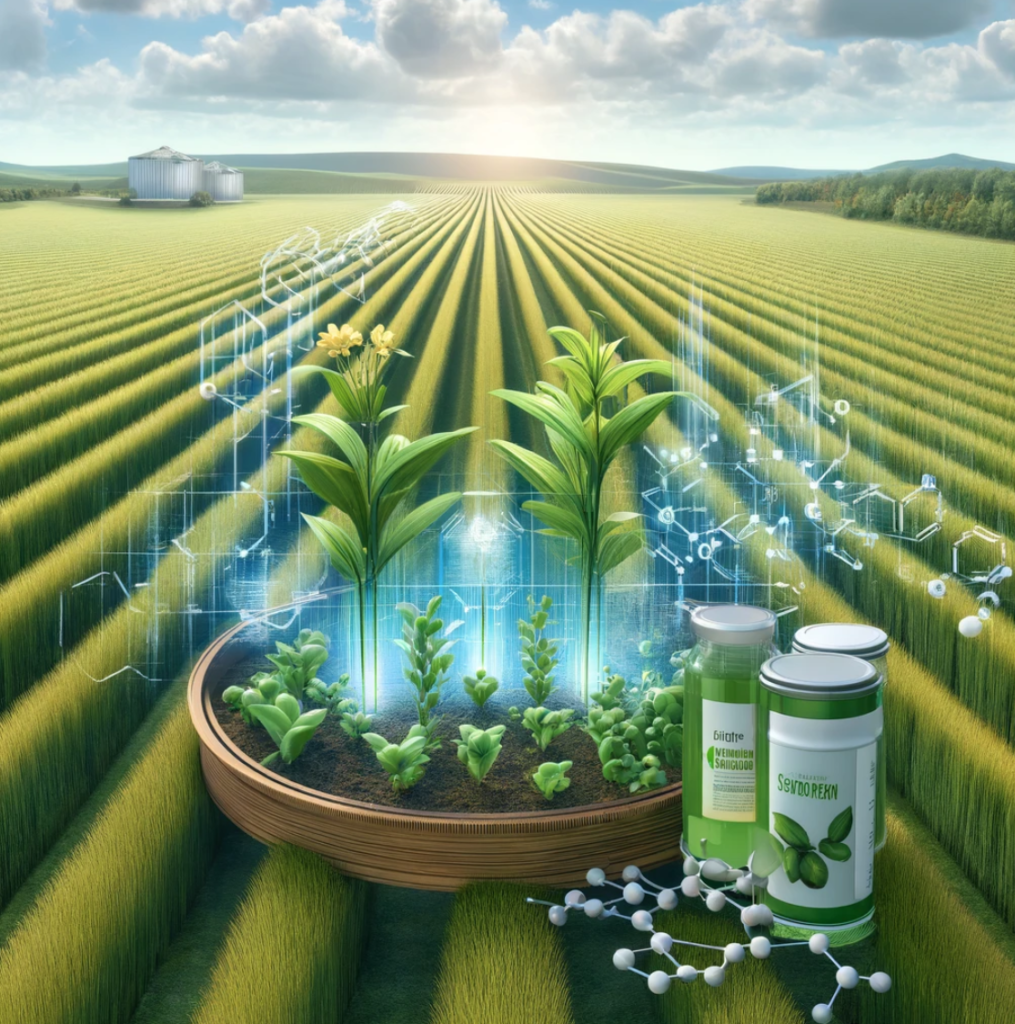
- Disease Resistance: Boosts plant immunity, providing resistance against various pathogens, including fungi, bacteria, and viruses.
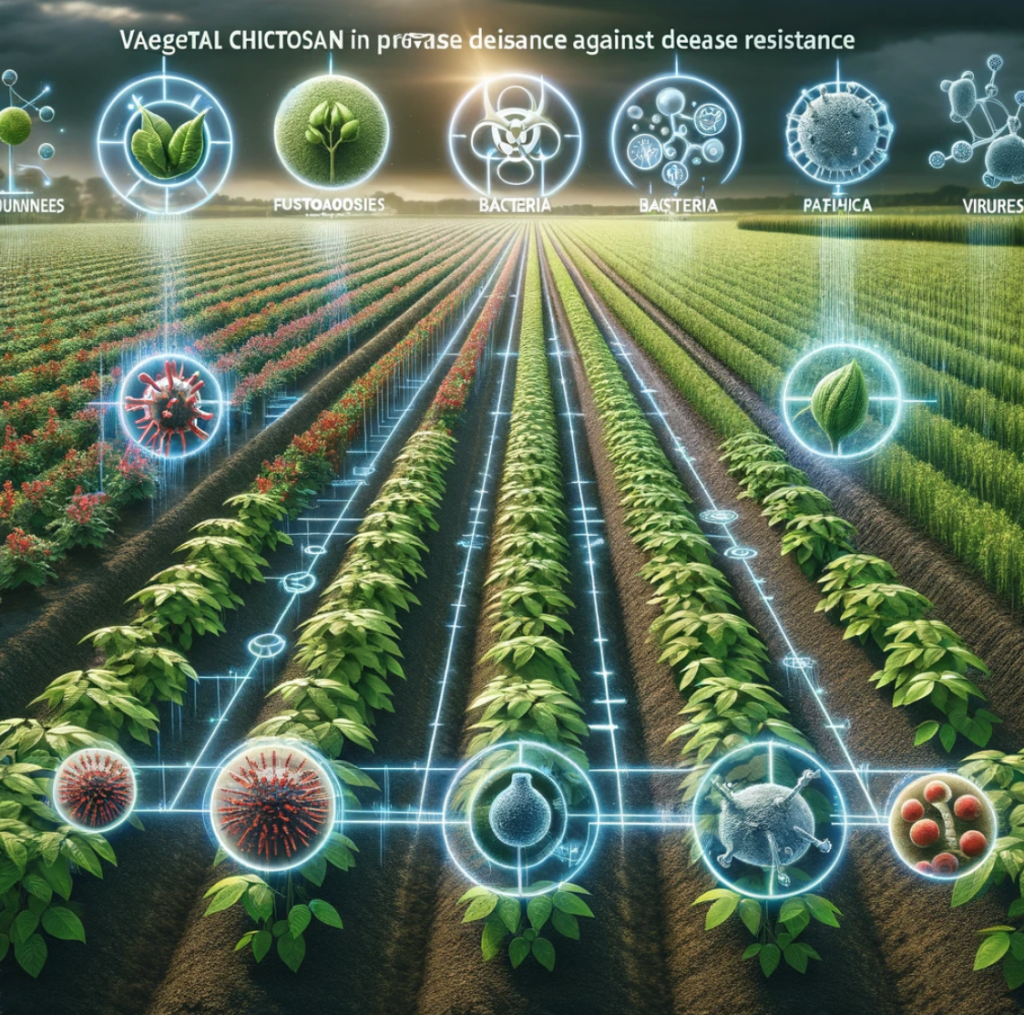
- Pest Deterrence: Acts as a natural deterrent to several agricultural pests.
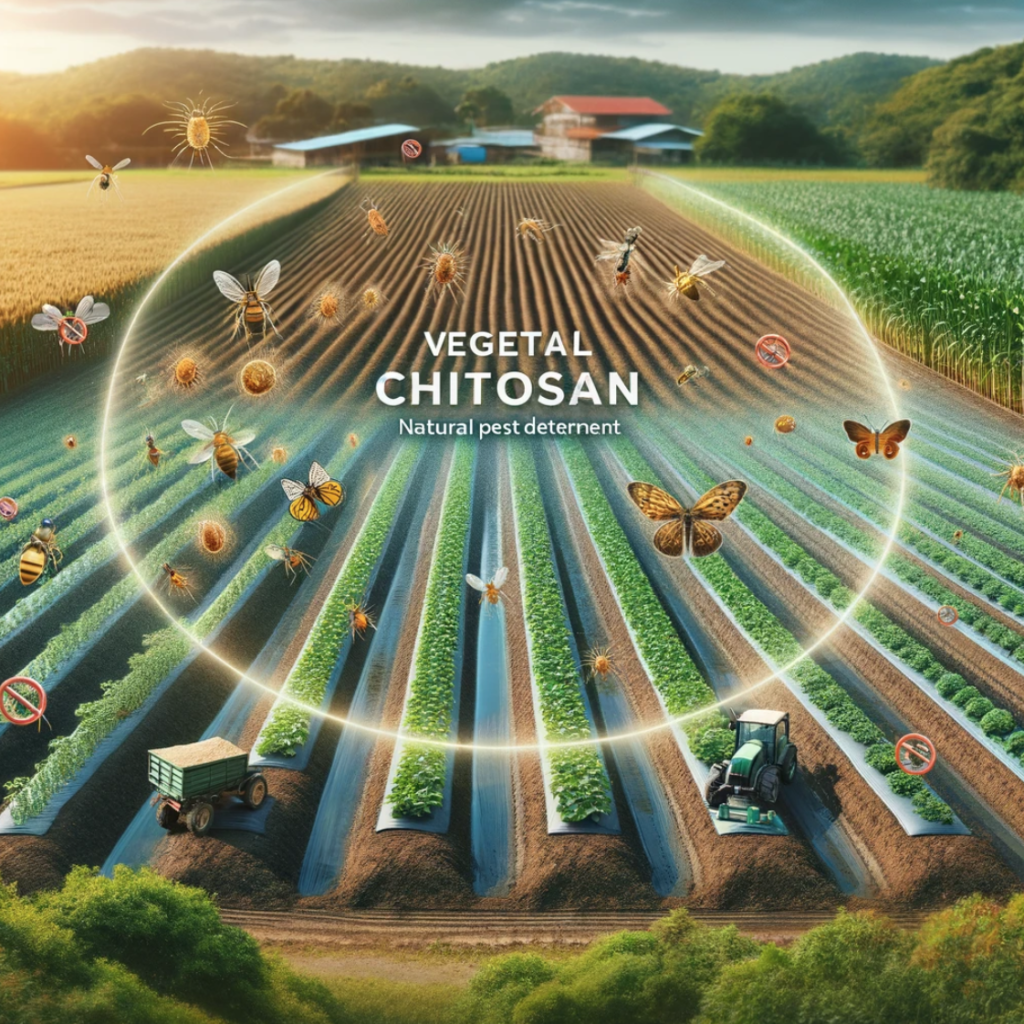
- Soil Health Improvement: Contributes to soil restructuring, enhancing its water and nutrient retention capabilities.
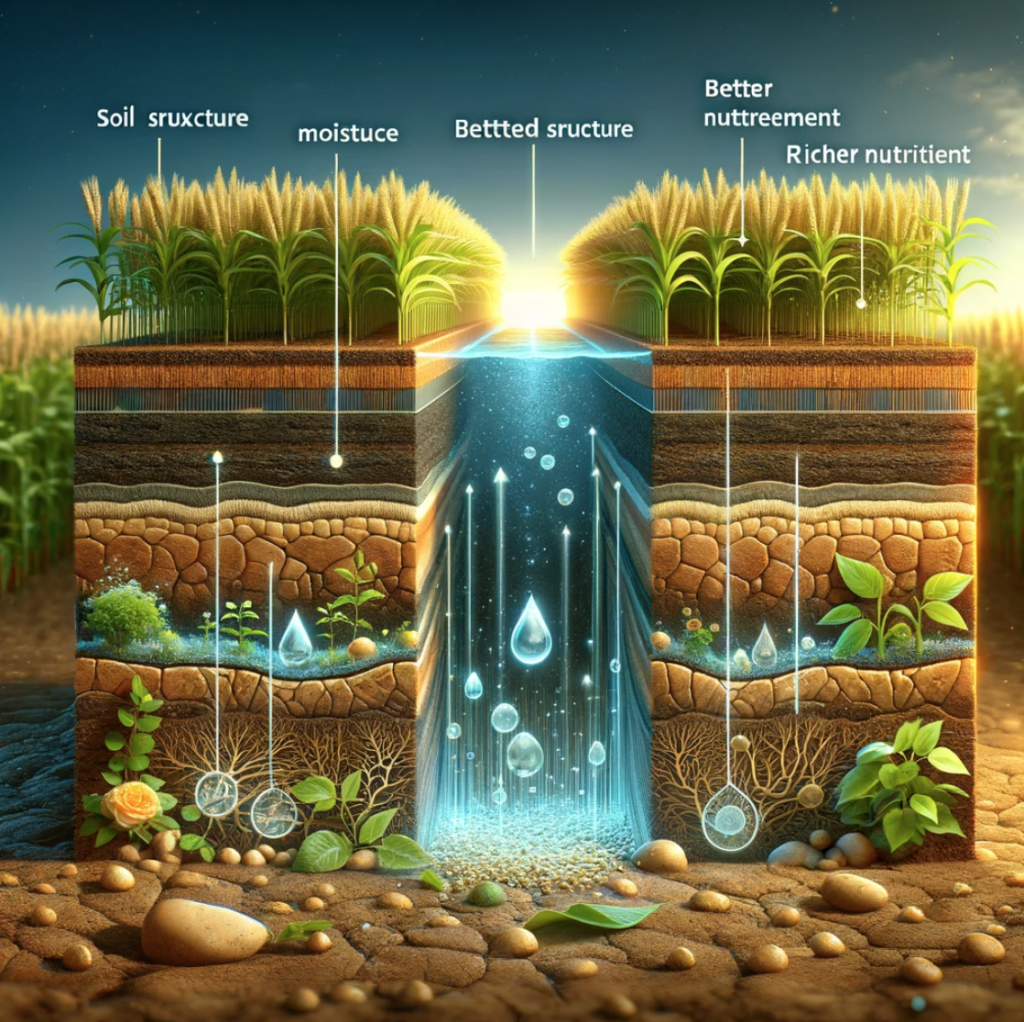
- Seed Germination: Improves seed germination rates and early plant development.
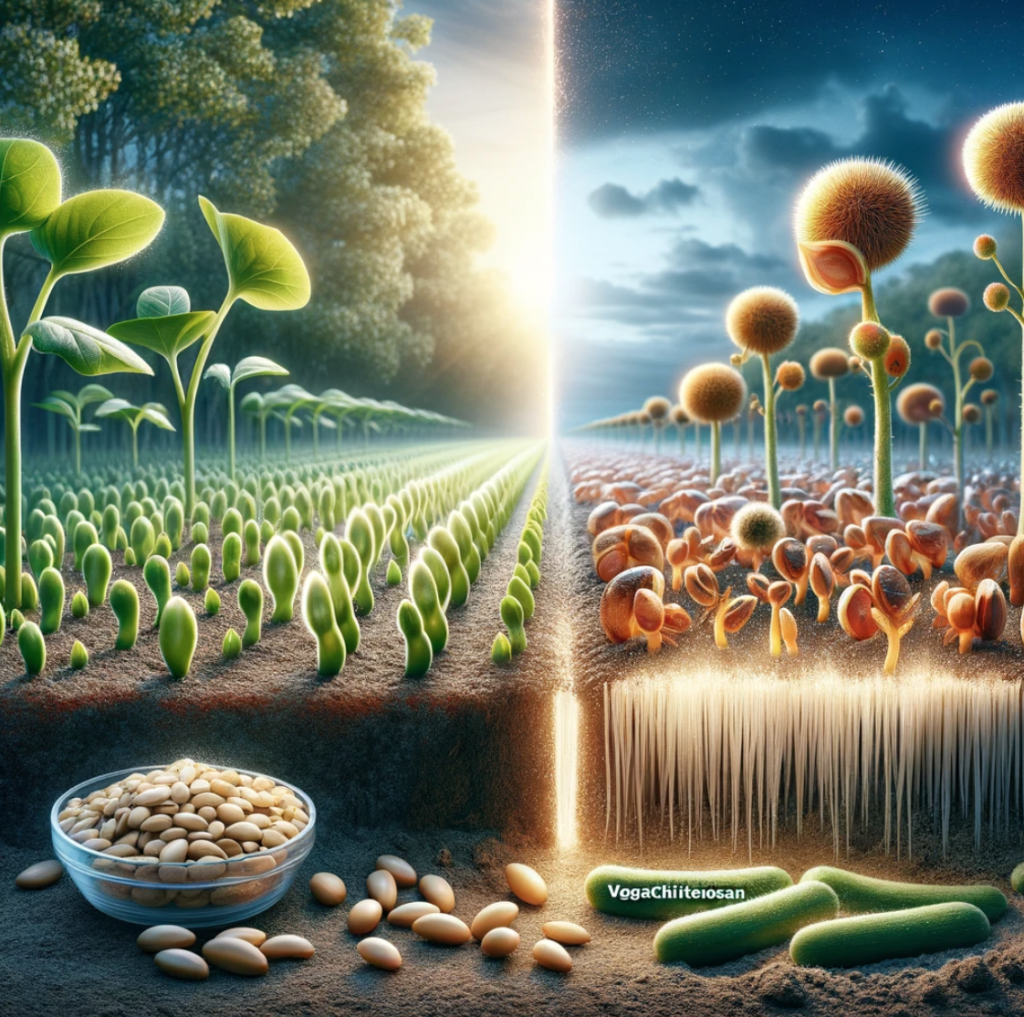
- Stress Tolerance: Enhances plants’ resilience against environmental stresses like drought, salinity, and heavy metals.
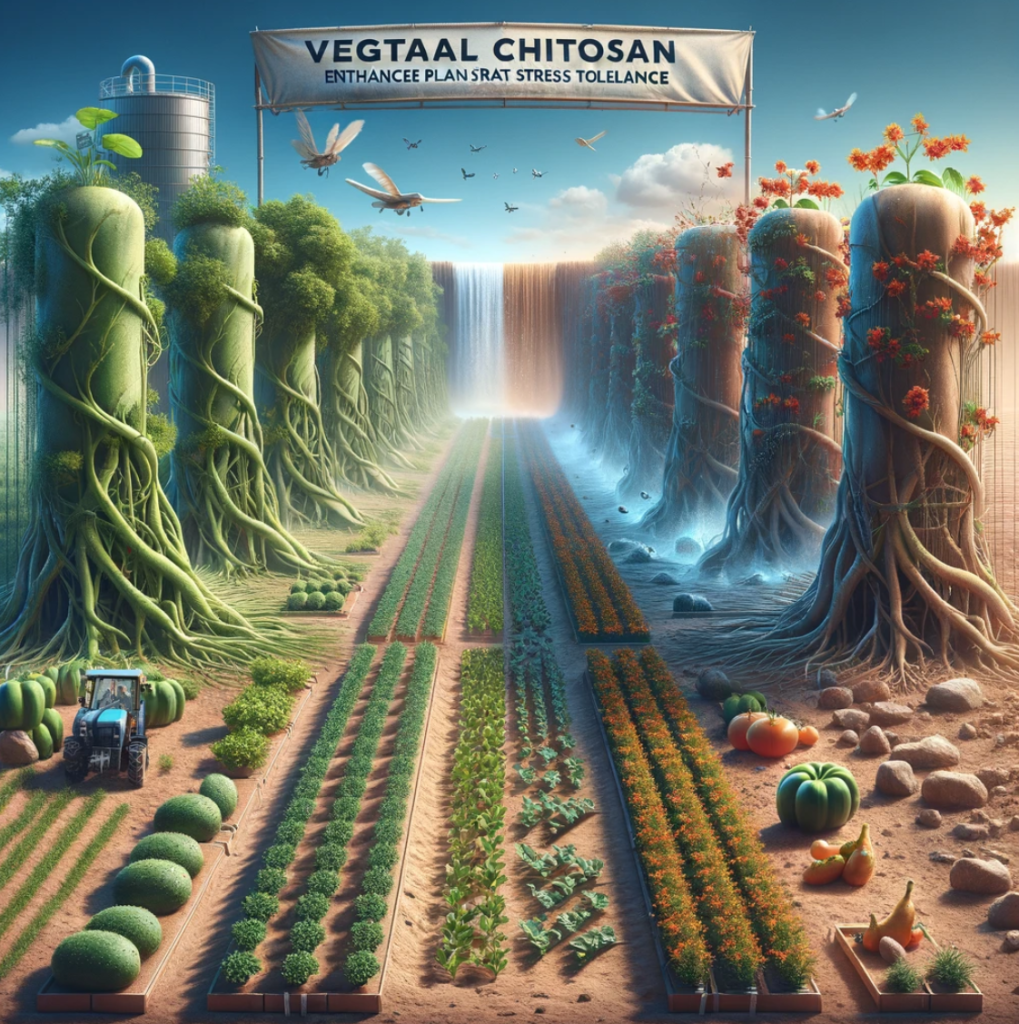
Functions of Vegetal Chitosan in Agriculture
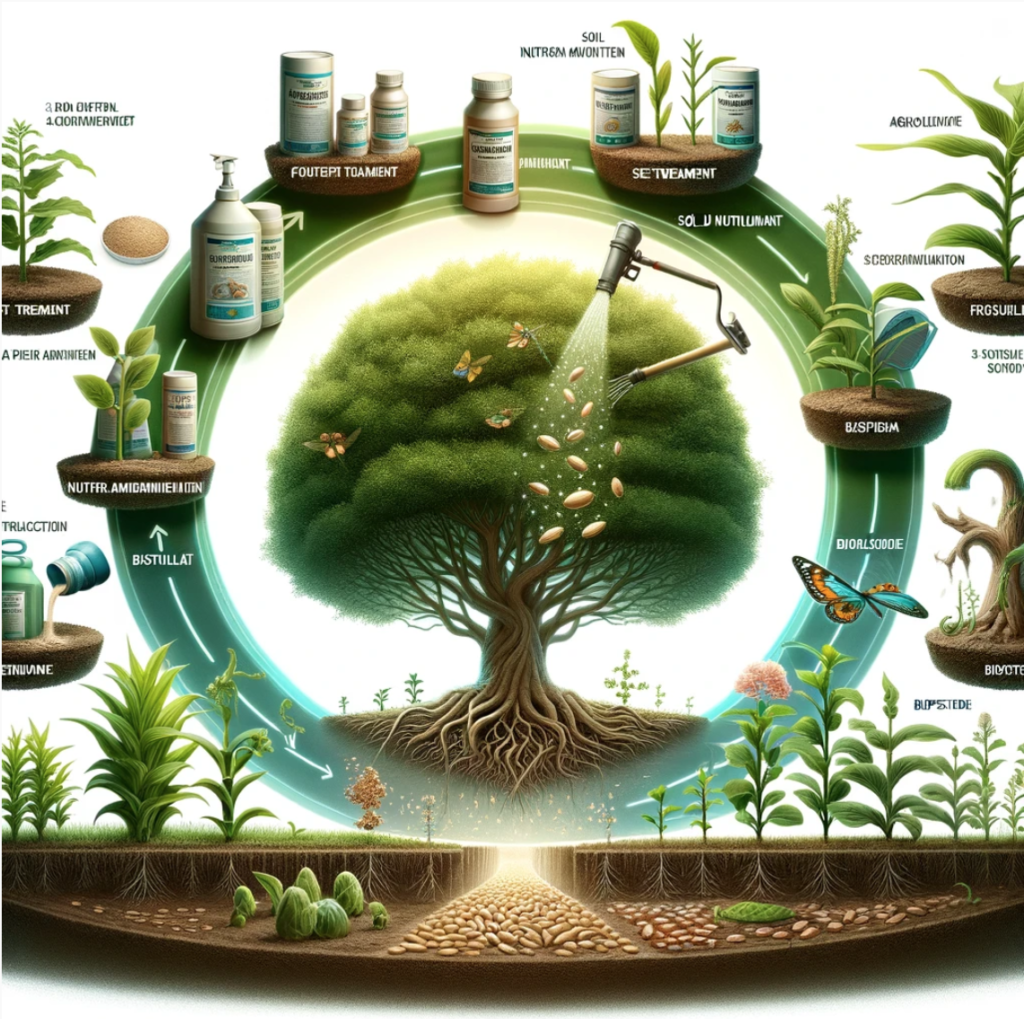
- Biopesticide: Used in foliar sprays or soil additives for pest control.
- Biostimulant: Promotes overall growth and health of plants.
- Soil Amendment: Improves soil quality and nutrient availability.
- Seed Treatment: Enhances seed germination and early growth when coated with chitosan.
- Foliar Application: As a spray, it can trigger plant defense mechanisms.
Dosage and Application
The optimal dosage of vegetal chitosan can vary significantly based on crop type, intended purpose (like growth enhancement or pest control), and the product’s specific formulation.
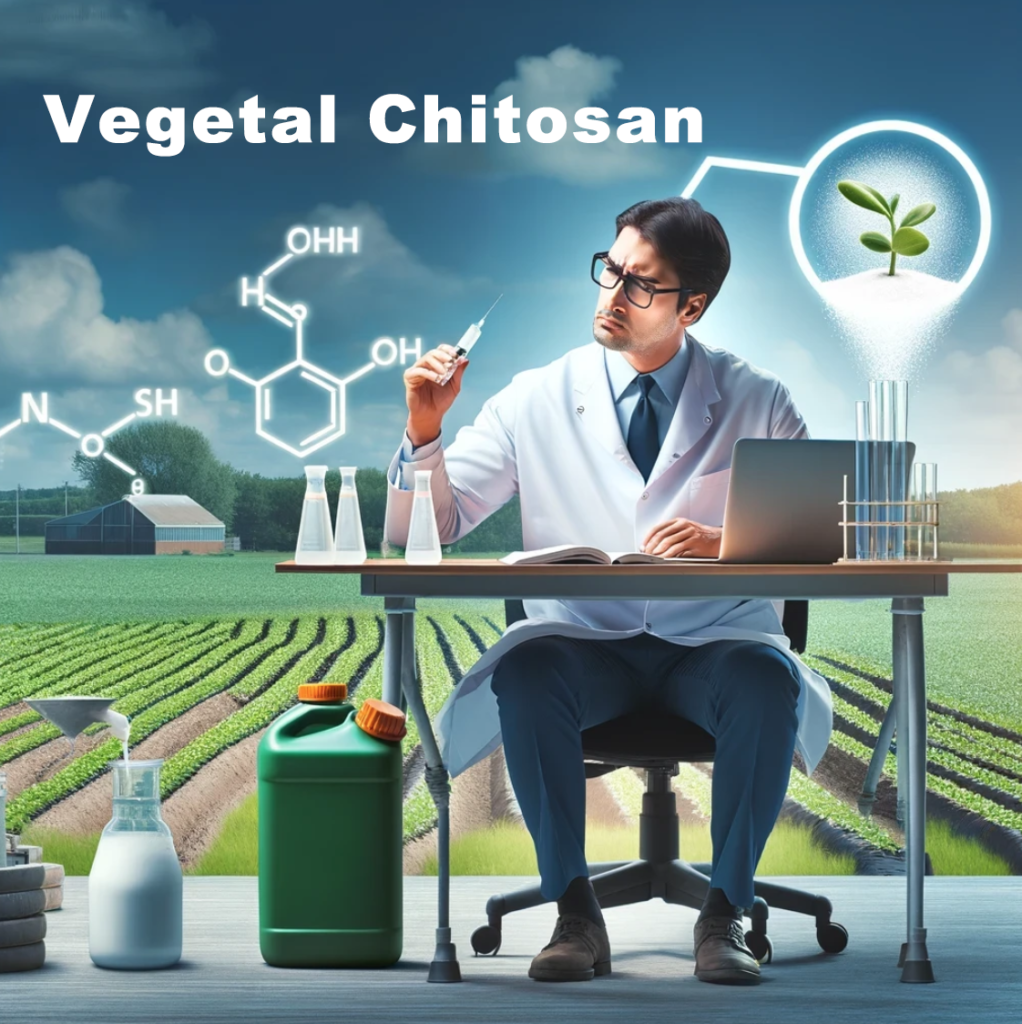
- Concentration: Typically used in concentrations ranging from 0.1 to 1.0% for foliar applications.
- Application Method: Can be applied as a foliar spray, seed treatment, soil amendment, or through irrigation systems.
- Frequency: The frequency depends on the agricultural need, varying from a single application (e.g., seed treatment) to multiple applications throughout the growing season for ongoing pest and disease control.
Important Considerations
- Environmental Impact: Vegetal chitosan is biodegradable and environmentally friendly, making it a preferred choice for sustainable agriculture practices.
- Regulatory Approvals: It’s essential to comply with local agricultural regulations regarding the use of biostimulants and biopesticides.
- Compatibility: Checking compatibility with other agricultural inputs is crucial for effectiveness.
For optimal results, it’s advisable for farmers and growers to consult with agricultural experts or extension services, tailored to their specific crops and local conditions. It’s also important to follow the manufacturer’s instructions for the vegetal chitosan product being used.
4. What are the common forms of chitosan used in agriculture?
In agriculture, chitosan is commonly used in various forms to leverage its beneficial properties. And each form of chitosan used in agriculture has distinct benefits, functions, and recommended dosages, tailored to specific agricultural applications. These includes:
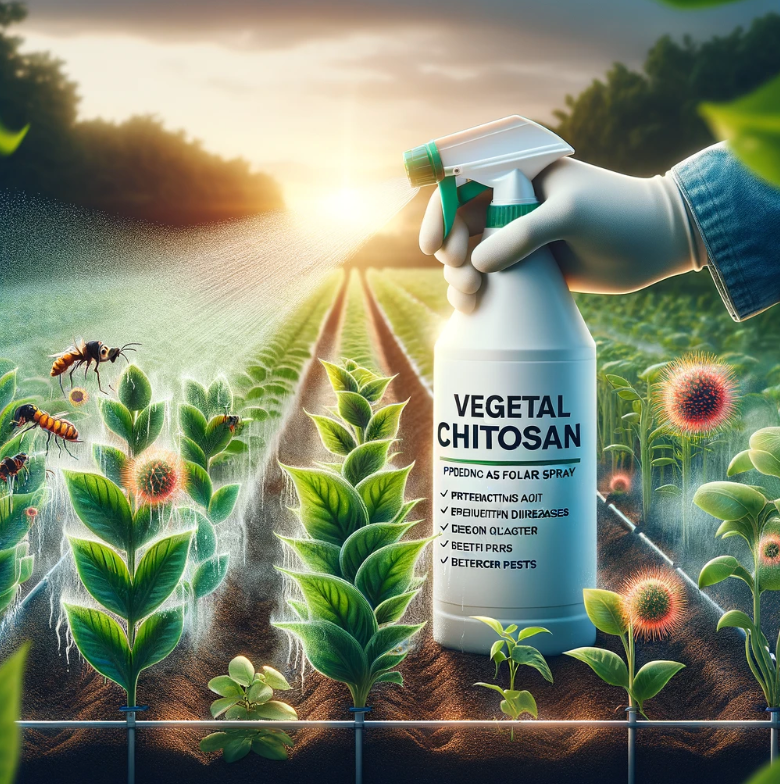
- Foliar Sprays: Applied directly to plant leaves, helping in disease prevention and pest deterrence.
- Benefits: Protects against fungal, bacterial, and viral infections; repels pests.
- Function: Stimulates plant defense mechanisms when applied to leaves.
- Dosage: Generally used in concentrations of 0.1-1.0%. Frequency and amount depend on crop type and disease or pest pressure.
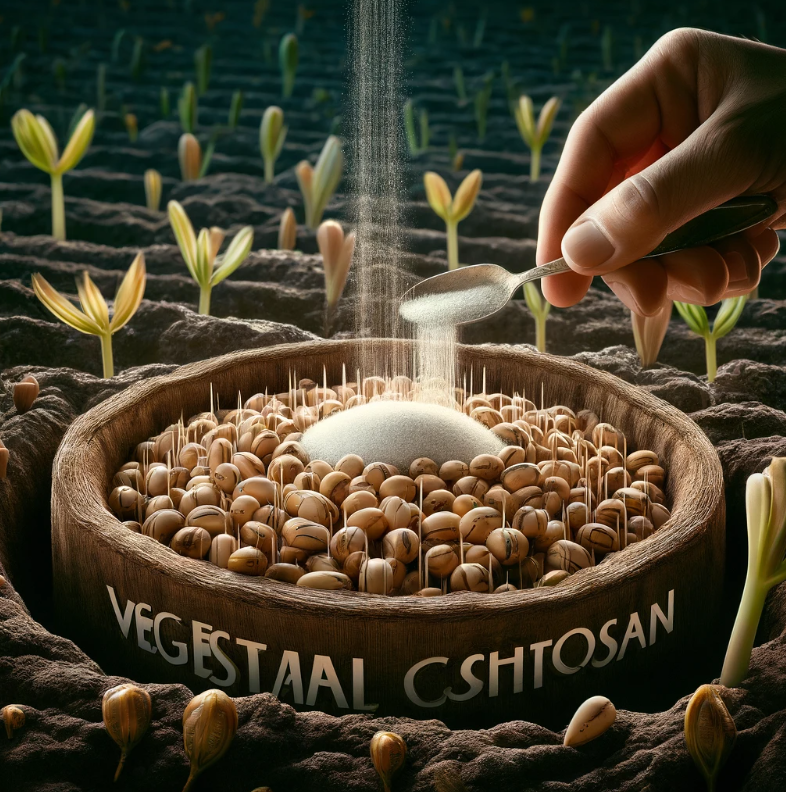
- Seed Treatments: Coating seeds with chitosan enhances germination and provides early protection against diseases.
- Benefits: Improves germination rates, early seedling growth, and provides initial disease protection.
- Function: Coats seeds to enhance growth and immunity.
- Dosage: Seed coating solutions typically have chitosan concentrations of 0.5-1.5%. Applied as a coating before sowing.
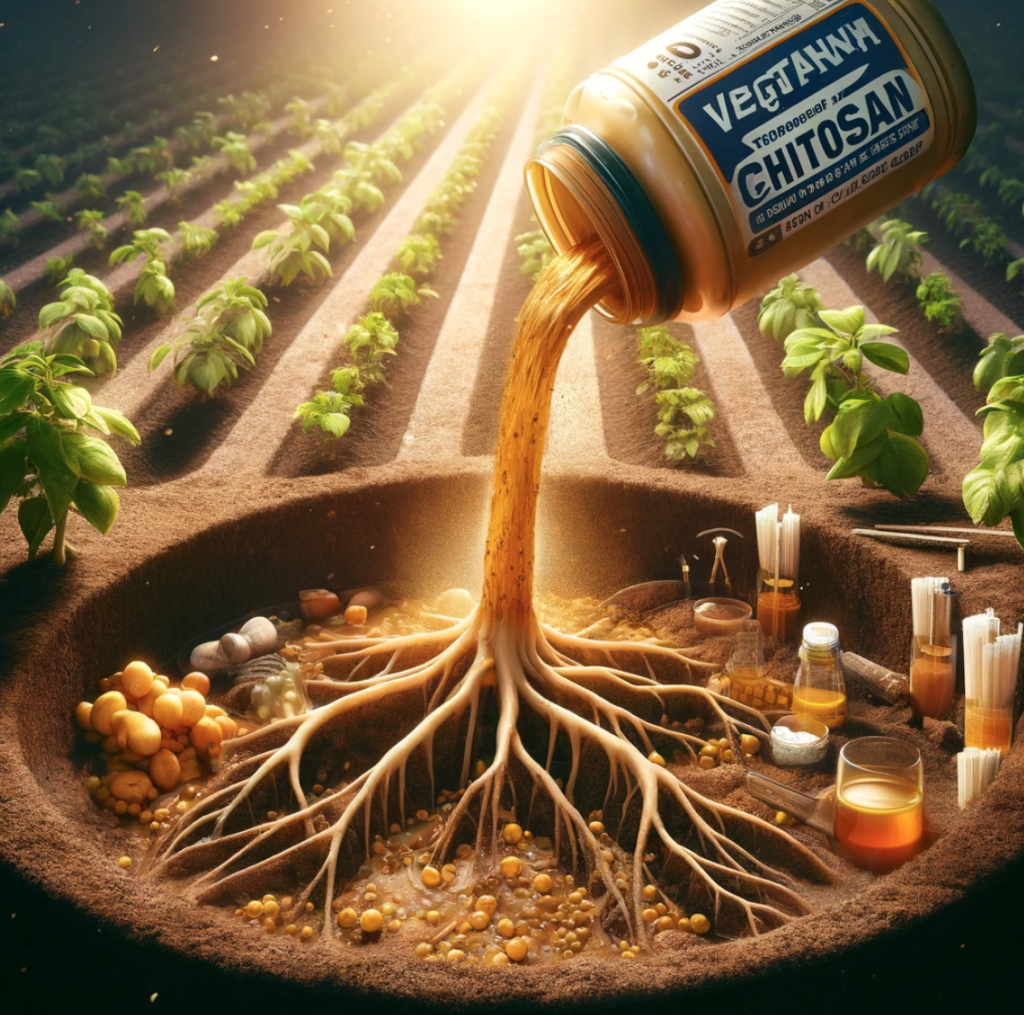
- Soil Amendments: Mixed with soil to improve its quality, which aids in water retention and stimulates plant root growth.
- Benefits: Enhances soil quality, increases water retention, and promotes root growth.
- Function: Mixed with soil to improve its structure and microbial activity.
- Dosage: Varied based on soil type and condition, generally applied at the start of the crop cycle or as needed.
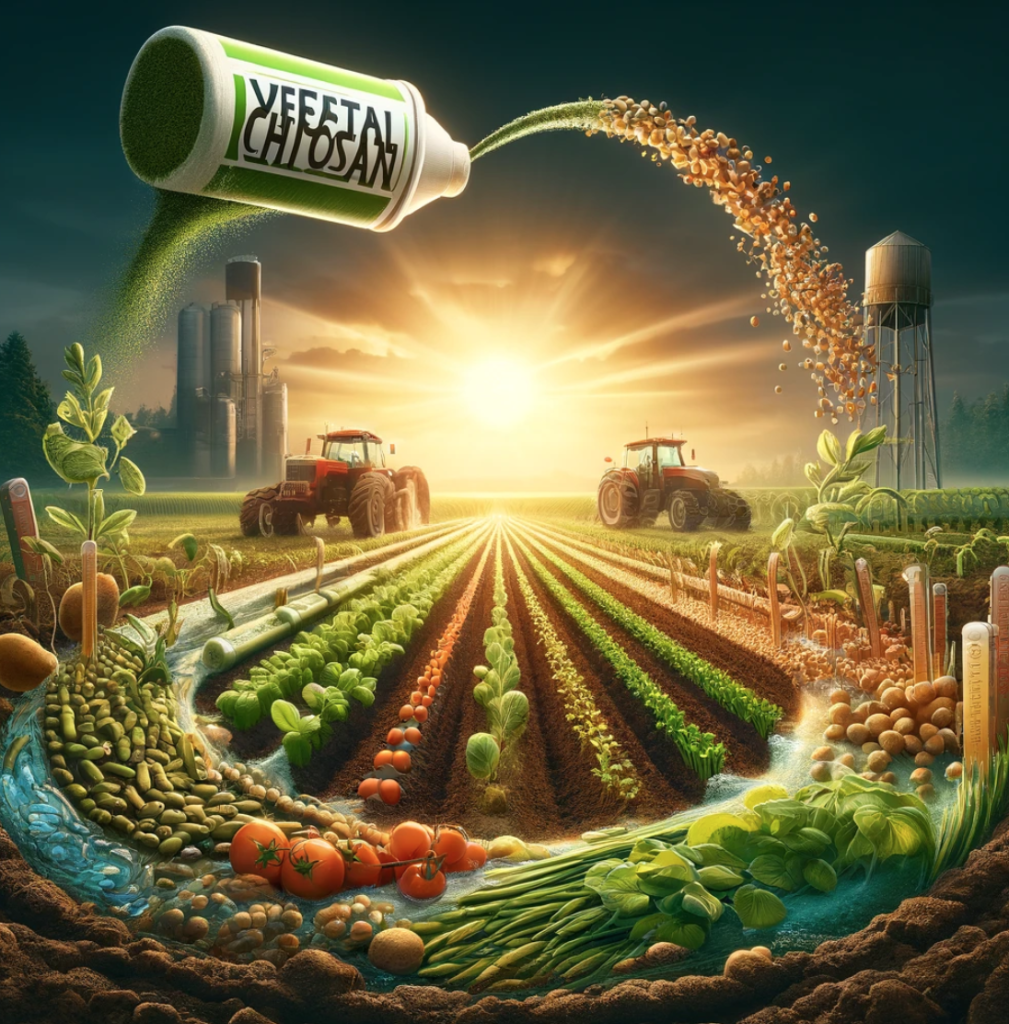
- Fertilizer Additives: Incorporated into fertilizers to boost nutrient uptake efficiency and overall soil health.
- Benefits: Increases nutrient uptake efficiency; enhances soil health.
- Function: Incorporated into fertilizers to boost their efficacy.
- Dosage: Usually a small percentage of the overall fertilizer composition; specific ratios depend on the fertilizer type and crop requirements.
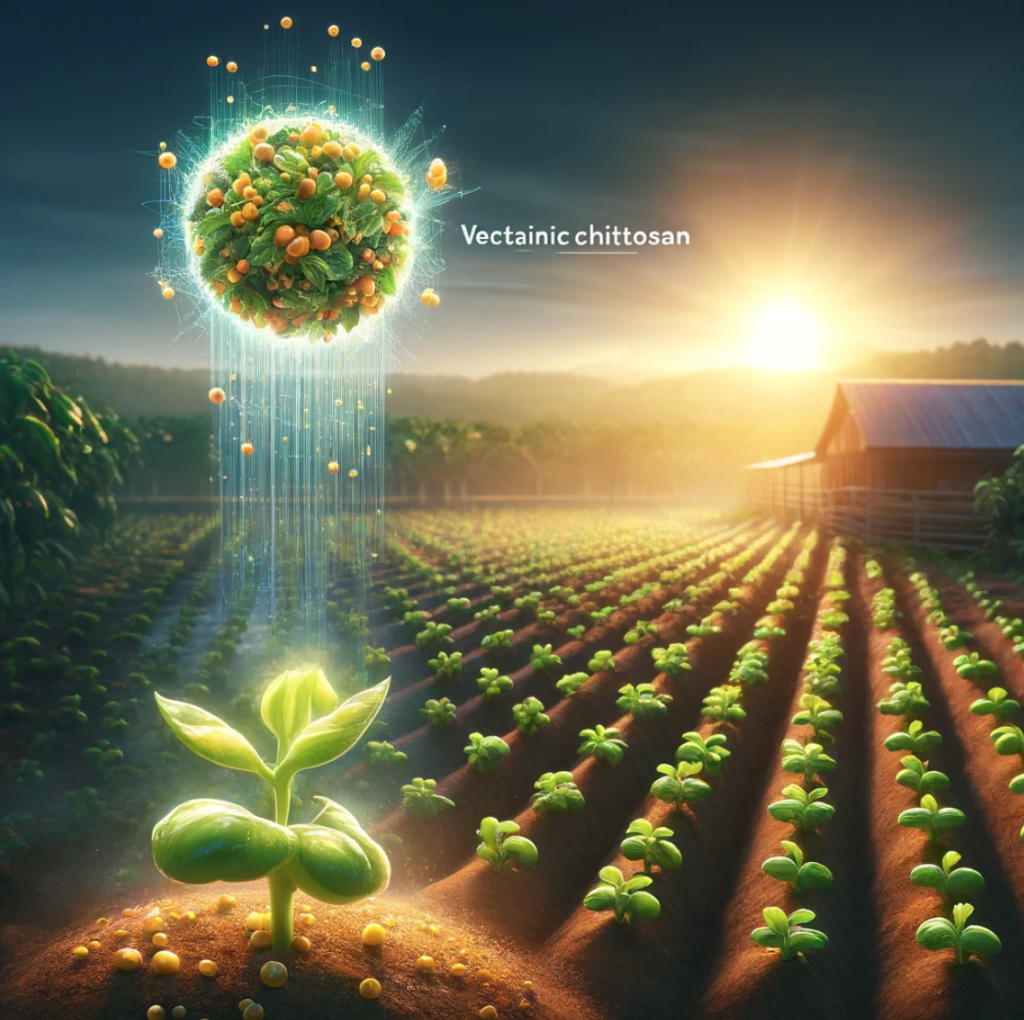
- Chitosan Nanoparticles: Used for targeted delivery of nutrients or protective agents to specific parts of the plant.
- Benefits: Provides targeted delivery of nutrients or pesticides, enhancing efficiency.
- Function: Used for precise application to plants, minimizing waste.
- Dosage: Highly specific and based on the targeted need; generally used in minimal quantities due to their high efficiency.
General Considerations
- Crop and Environmental Specificity: The effectiveness and required dosage can vary based on the crop, stage of growth, and environmental conditions.
- Product Specifications: Always follow the manufacturer’s guidelines for specific products.
- Regulatory Compliance: Ensure that usage complies with local agricultural regulations.
- Expert Consultation: It’s advisable to consult with agricultural experts for tailored advice.
These forms are chosen based on specific needs such as improving plant health, protecting against pests, or enhancing crop yield. Each form exploits chitosan’s properties like biodegradability, non-toxicity, and its ability to enhance plant immunity and growth.
Meanwhile, each form of chitosan application aims to harness its unique properties to improve crop health and yield, contributing to sustainable and efficient farming practices.
5. In agriculture application, what is the difference between crustacean chitosan and vegetal chitosan?
Choosing between crustacean-derived chitosan and vegetal (plant-based) chitosan in agriculture depends on various factors, including effectiveness, availability, cost, and environmental considerations. Here’s a comparison:
Crustacean Chitosan
- Source: Derived from the shells of crustaceans such as crabs, shrimp, and lobsters.
- Effectiveness: Generally, it has a well-established history of use in agriculture with proven efficacy.
- Availability: Widely available, but the supply can depend on the seafood industry.
- Cost: Production costs can be lower due to the processing required to extract chitosan from shells.
- Environmental Impact: Utilizes waste products from the seafood industry, which can be seen as a form of recycling. However, concerns exist about potential allergens and the sustainability of marine resources.

Vegetal Chitosan
- Source: Derived from the cell walls of certain fungi or other non-animal sources, currently typical source is mushroom and apsergillus niger.
- Effectiveness: While effective, it may have different characteristics and efficacy profiles due to variations in molecular structure compared to crustacean chitosan.
- Availability: Emerging in the market, but not as widely available as crustacean chitosan.
- Cost: Potentially lower environmental and ethical costs, but the production costs can vary depending on the source and extraction method, it is more expensive than traditional crustacean chitosan.
- Environmental Impact: Offers a more sustainable and vegan-friendly alternative, avoiding the use of animal sources.
Effectiveness in Agriculture
- Crop and Disease Specificity: The effectiveness can be crop-specific and also dependent on the type of pathogens or pests targeted. Some crops or diseases might respond better to one type of chitosan over the other.
- Environmental Conditions: The performance of both types of chitosan can be influenced by environmental conditions like soil pH, temperature, and moisture.
- Application Methods: The method of application (e.g., foliar spray, soil amendment, seed treatment) can also influence the effectiveness of both types of chitosan.
Conclusion
- Comparative Studies: Direct comparative studies between vegetal and crustacean chitosan in various agricultural applications would provide the best insights.
- Trial and Evaluation: For practical purposes, it’s often recommended to conduct trials or refer to existing research specific to the type of crop and environmental conditions.
Key Considerations
- Molecular Structure and Quality: The effectiveness of chitosan as a biostimulant or biopesticide can depend on its molecular weight and degree of deacetylation, which can vary between sources.
- Application Needs: The choice may depend on the specific agricultural application and the results from trials or studies on specific crops.
- Regulatory Factors: Depending on the region, there may be different regulatory approvals for crustacean vs. vegetal chitosan.
- Sustainability and Ethical Concerns: Vegetal chitosan is often preferred by those seeking more sustainable and ethically sourced products.
Recommendation
It’s advisable to consider both the scientific research available for the specific type of chitosan and its application in your particular agricultural context. Trial tests can be helpful to determine which type works best for your needs. Consulting with agricultural experts or agronomists can provide additional insights tailored to your specific requirements and local conditions.
6. Which type of chitosan is best for agriculture: acid-soluble chitosan, chitosan hydrochloride, or chitosan oligosaccharide?
When considering the use of chitosan in agriculture, the choice between acid-soluble chitosan, chitosan hydrochloride, and chitosan oligosaccharide depends on several factors including the specific agricultural application, effectiveness, ease of use, and crop safety. Each type has its unique characteristics and benefits:
Acid-Soluble Chitosan
- Characteristics: Soluble in acidic solutions, typically derived from the deacetylation of chitin.
- Uses: Commonly used for its antifungal properties and as a growth stimulant.
- Advantages: Effective in enhancing plant immunity and improving yield.
- Considerations: The acidic nature might be a concern for certain soil types or crops.
Chitosan Hydrochloride (Water-soluble)
- Characteristics: A hydrochloride salt form of chitosan, known for its water solubility.
- Uses: Often used in foliar applications and as a seed treatment.
- Advantages: Better solubility in water makes it easier to apply, and it’s generally effective in promoting seed germination and plant growth.
- Considerations: It’s important to manage the concentration carefully to avoid potential phytotoxicity.
Chitosan Oligosaccharide (Water-soluble)
- Characteristics: Consists of shorter polymer chains, enhancing its solubility and bioactivity.
- Uses: Widely used for its biostimulant and biopesticide properties.
- Advantages: High bioactivity means it can be effective at lower concentrations, and its smaller molecular size allows for easier uptake by plants.
- Considerations: Might be more expensive due to the processing required to break down chitosan into oligosaccharides.
Key Considerations for Selection
- Specific Agricultural Needs: The choice depends on what you are trying to achieve, e.g., disease control, growth stimulation, or improved stress tolerance.
- Crop Safety: Each type may interact differently with various crops, so it’s important to consider crop tolerance.
- Environmental Conditions: Soil pH, climate, and other environmental factors can influence the effectiveness of different chitosan types.
- Application Method: Ease of application (e.g., foliar spray, soil amendment) and required concentration levels can vary between types.
- Cost-Effectiveness: Consider the cost relative to the benefits and effectiveness for your specific use case.
- Regulatory Compliance: Ensure the chosen type is compliant with local agricultural regulations.
Recommendation
It’s often advisable to conduct trials or refer to agricultural research specific to the crop and region to determine the most effective type of chitosan. Consulting with agricultural experts or extension services can also provide valuable guidance tailored to your specific conditions and requirements.
7. Are there successful trials demonstrating chitosan’s effectiveness in agriculture?
Yes, there have been several successful trials and studies demonstrating the effectiveness of chitosan in agriculture. These studies have covered various aspects of agricultural application, including plant growth enhancement, disease resistance, pest control, and improvement of crop yield and quality. Here are some key highlights:
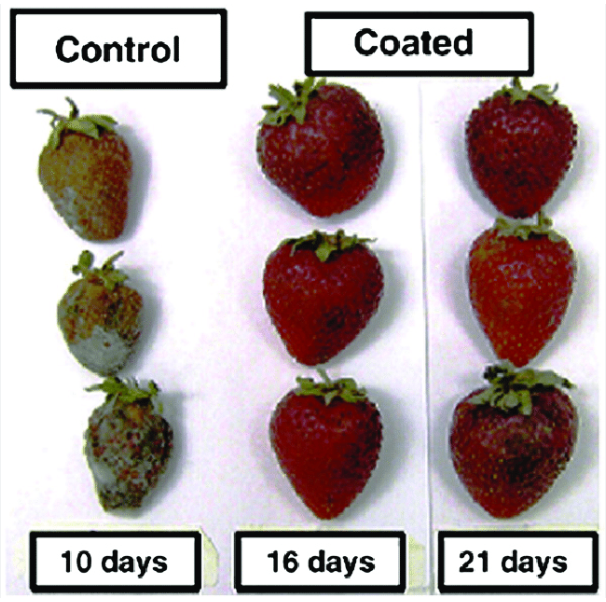
- Plant Growth and Yield: Research has shown that chitosan can significantly promote plant growth and increase yield. Studies on crops like tomatoes, cucumbers, and strawberries have demonstrated improved growth and higher yields when treated with chitosan.
- Disease Resistance: Chitosan has been effective in increasing plant resistance to fungal, bacterial, and viral diseases. Trials on various crops have shown reduced incidence of diseases like blight, rot, and mildew after chitosan application.
- Pest Control: Chitosan is also known to be effective in repelling certain agricultural pests, thereby reducing the reliance on chemical pesticides. Trials have indicated its effectiveness against pests like aphids and mites.
- Seed Germination and Seedling Growth: Studies have shown that chitosan treatments can enhance seed germination rates and stimulate the early growth of seedlings, contributing to healthier and more robust plants.
- Stress Tolerance: Chitosan has been observed to improve plant tolerance to environmental stresses such as drought, salinity, and heavy metal toxicity. This is particularly valuable in regions facing adverse climatic conditions.
- Soil Health: Beyond direct plant benefits, chitosan has been used to improve soil structure, enhance microbial activity, and increase nutrient availability.
- Post-Harvest Preservation: Chitosan has been successfully used in extending the shelf life and preserving the quality of fruits and vegetables post-harvest.
These trials and studies are conducted across different geographic locations and on a variety of crops, underlining the versatile and broad-spectrum benefits of chitosan in agriculture. However, it’s important to note that the effectiveness of chitosan can vary based on factors like its concentration, molecular weight, source, and the specific crop and environmental conditions. Continued research and field trials help in optimizing its use and understanding its full potential in sustainable agriculture.
8. In summary of vegetal chitosan used in agriculture
Vegetal chitosan, sourced from non-animal origins like fungi, is emerging as a sustainable alternative in agricultural practices. Its benefits in agriculture are multifaceted, including stimulating plant growth, enhancing yield, boosting disease resistance, and acting as a natural deterrent to pests.
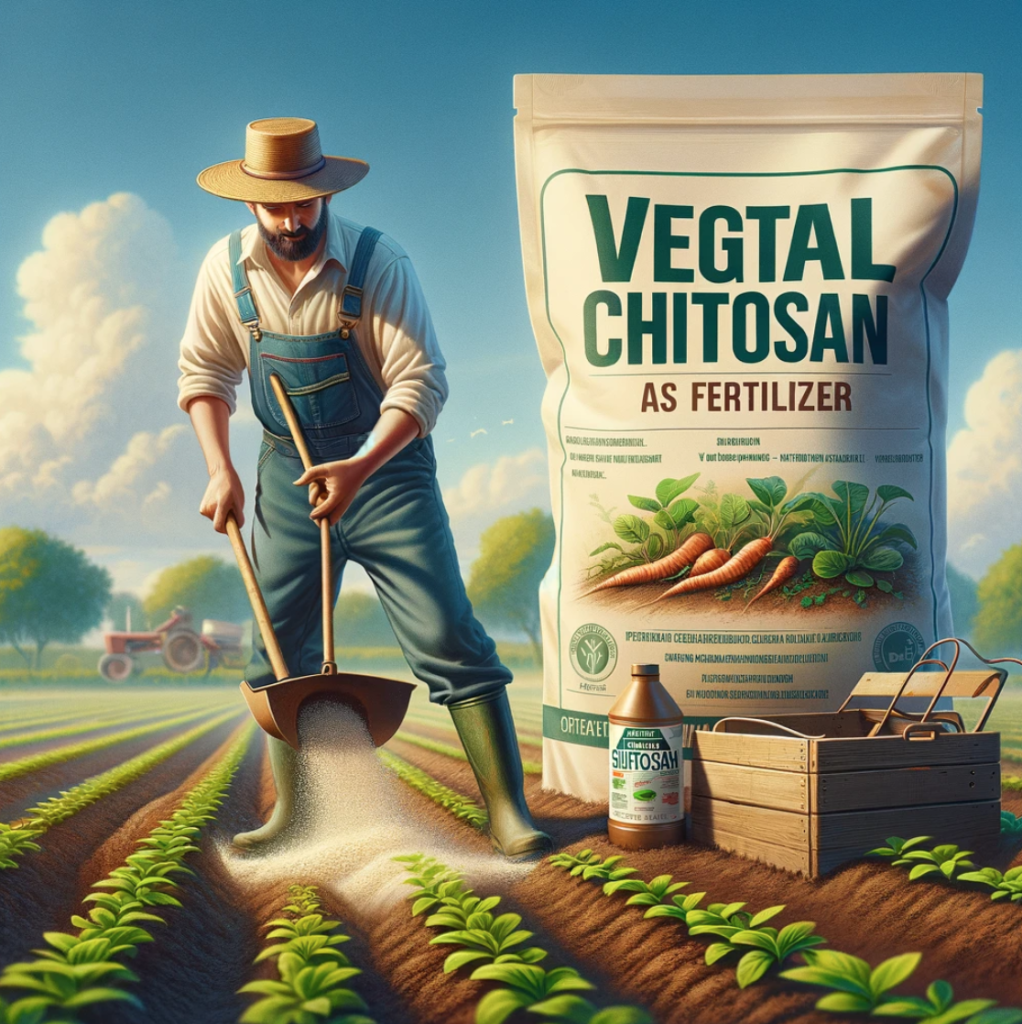
This biopolymer improves seed germination rates, increases plant stress tolerance, and contributes to soil health improvement. Its applications span from being a biopesticide and biostimulant to a soil amendment and seed treatment. The effectiveness of vegetal chitosan can vary depending on factors like its molecular structure, crop type, and environmental conditions. Being environmentally friendly and sustainable, it offers a viable option for those seeking eco-conscious agricultural solutions.
While the choice between vegetal and traditional crustacean-derived chitosan depends on specific agricultural needs, vegetal chitosan holds promise for future agricultural advancements due to its plant-based origin and biodegradability.

